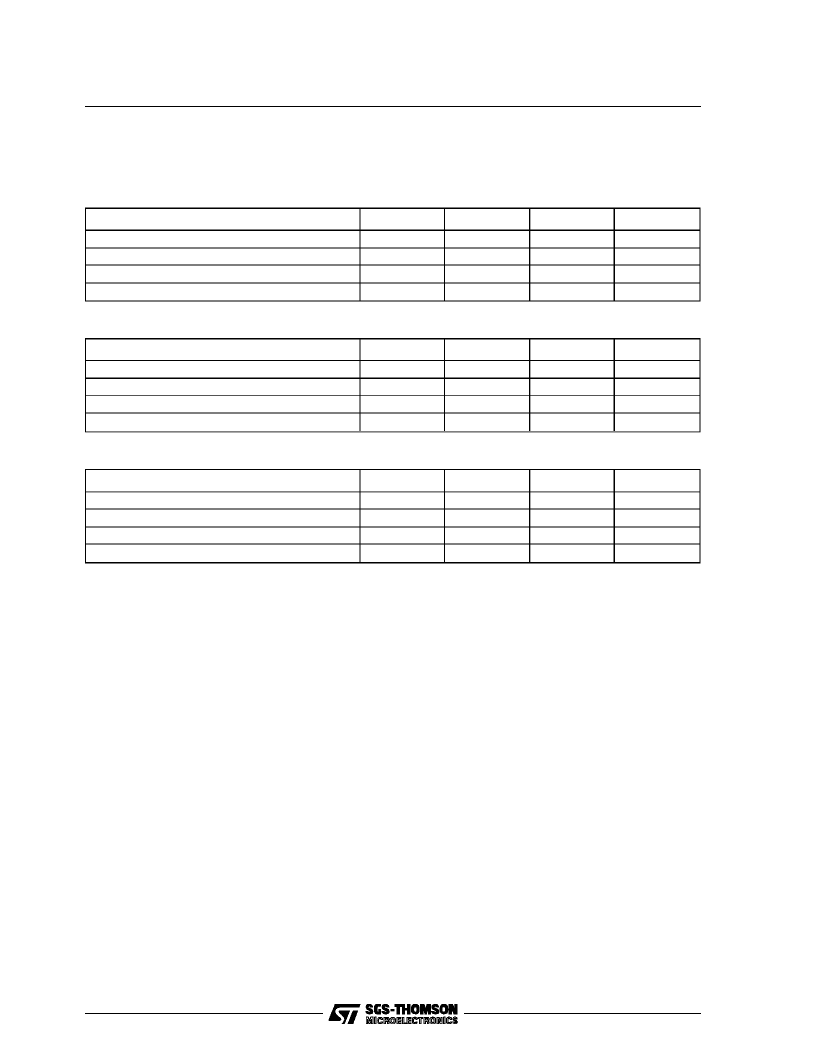- 您現(xiàn)在的位置:買賣IC網(wǎng) > PDF目錄369714 > L6372 OCTAL INDUSTRIAL INPUT INTERFACE(253.91 k) PDF資料下載
參數(shù)資料
| 型號: | L6372 |
| 英文描述: | OCTAL INDUSTRIAL INPUT INTERFACE(253.91 k) |
| 中文描述: | 八路工業(yè)輸入接口(253.91十一) |
| 文件頁數(shù): | 8/15頁 |
| 文件大?。?/td> | 253K |
| 代理商: | L6372 |

The masks in figure3 for the cases a), b), c) plot,
in a I/V diagram (horizontallythe line input current
and vertically the line input voltage), the resulting
line input characteristics. They appear as three
curves for each diagram, starting from the origin
and running close to each other. One shows the
case where all tolerances combine to generate
the typical case, and the other two to generate
the opposite extreme characteristics. In the plots
the boundaries of the regions recommended by
the ”IEC 1131 24VDC, type 2” for the different in-
put decoding functions to take place,are shown.
Other choices for R
1
, R
2
and R
ref
are of course
possible, and case by case the set of values shall
be different, accordingto the differentdesign con-
straint of the application. In the above paragraph
it has been assumed that the LEDs are of the
green or yellow types (higher forward drop than
the more common redones).
CHANNEL PROTECTION
At the input of each channel, two diodes clamp
the voltage to V
s
and to ground. They have been
designedand sizedin orderto:
- exhibit a low forward voltage drop when
pulses of inrushing current up to 2A are
forced,V
f
typicalof 2V @ 2A (2A corresponds
to a voltage of 2KV if a resistor of 1K
is put
externallyin series to each channel input);
- avoid interference of noise pulses on the ad-
jacent channels (a 1A pulse lasting up to
100
μ
s won’t be felt in the adjacent channels);
- avoid interferencewith the overallchip opera-
tion due to parasitic elements in the inte-
grated circuit structure (very low leakage to
the chip substrate during forward conduction,
and no parasitic transistors with the other dif-
fused structuresclose by in the chip).
The series resistance R
1
combines with the two
protection diodes at each channel input, to imple-
ment an effective protection from any line distur-
bance.
INPUT CHANNEL
On each of its 8 inputs the L6372 continuously
monitors,
by
means
whether:
- it is possible to sink the high level current
(equal to or
greater than the level pro-
grammedby an externalresistor R
ref
, called I
2
and typicallyset at 6.8 mA ); or
- if at least it is possible to sink a current equal
to, or greater than the low level current (fixed
inside the IC, called I
1
and having a typical
value of 550
μ
A ).
of
two
comparators,
In the following tables the conditionsof power dis-
sipation for the three cases are given.
For the calculation of the dissipated power, the
extreme case when all channel are working with
maximum current, maximum line voltage and
maximum supply voltage to the IC (unless other-
wise specified)has been considered.
Min.
Typ.
Max.
Unit
I
line-i
@ V
line-i
= 11V
I
line-i
@ V
line-i
= 30V
P
diss on chip@
V
line-i
= 30V
P
diss on board @
V
line-i
= 30V
6.12
6.12
1.45
1.79
6.80
6.80
1.56
1.96
7.48
7.48
1.65
2.11
mA
mA
W
W
a)
Min.
Typ.
Max.
Unit
I
line-i
@ V
line-i
= 11V
I
line-i
@ V
line-i
= 30V
P
diss on chip@
V
line-i
= 30V
P
diss on board @
V
line-i
= 30V
6.04
15.50
686
4.07
6.47
16.39
725
4.28
6.92
17.35
764
4.51
mA
mA
mW
W
c)
Min.
Typ.
Max.
Unit
I
line-i
@ V
line-i
= 11V
I
line-i
@ V
line-i
= 30V
P
diss on chip@
V
line-i
= 30V
P
diss on board @
V
line-i
= 30V
6.03
16.40
634
3.39
6.60
17.22
698
3.59
7.19
18.10
760
3.81
mA
mA
mW
W
b) (V
S
= 12V)
L6372
8/15
相關PDF資料 |
PDF描述 |
|---|---|
| L64290GC-15 | |
| L64290GC-20 | |
| L64324 | L64324 Intelligent Ethernet Switch |
| L64360 | ATM/SONET Segmentation and Reassembly Circuit |
| L64364 | L64364 ATMizer II+ ATM-SAR Chip programming guide 1/00 |
相關代理商/技術參數(shù) |
參數(shù)描述 |
|---|---|
| L6374 | 制造商:STMICROELECTRONICS 制造商全稱:STMicroelectronics 功能描述:INDUSTRIAL QUAD LINE DRIVER |
| L6374_08 | 制造商:STMICROELECTRONICS 制造商全稱:STMicroelectronics 功能描述:Industrial quad line driver |
| L6374DP | 功能描述:緩沖器和線路驅動器 Industrial Quad Line RoHS:否 制造商:Micrel 輸入線路數(shù)量:1 輸出線路數(shù)量:2 極性:Non-Inverting 電源電壓-最大:+/- 5.5 V 電源電壓-最小:+/- 2.37 V 最大工作溫度:+ 85 C 安裝風格:SMD/SMT 封裝 / 箱體:MSOP-8 封裝:Reel |
| L6374FP | 功能描述:緩沖器和線路驅動器 Industrial Quad Line RoHS:否 制造商:Micrel 輸入線路數(shù)量:1 輸出線路數(shù)量:2 極性:Non-Inverting 電源電壓-最大:+/- 5.5 V 電源電壓-最小:+/- 2.37 V 最大工作溫度:+ 85 C 安裝風格:SMD/SMT 封裝 / 箱體:MSOP-8 封裝:Reel |
| L6374FP013TR | 功能描述:緩沖器和線路驅動器 Industrial Quad Line RoHS:否 制造商:Micrel 輸入線路數(shù)量:1 輸出線路數(shù)量:2 極性:Non-Inverting 電源電壓-最大:+/- 5.5 V 電源電壓-最小:+/- 2.37 V 最大工作溫度:+ 85 C 安裝風格:SMD/SMT 封裝 / 箱體:MSOP-8 封裝:Reel |
發(fā)布緊急采購,3分鐘左右您將得到回復。